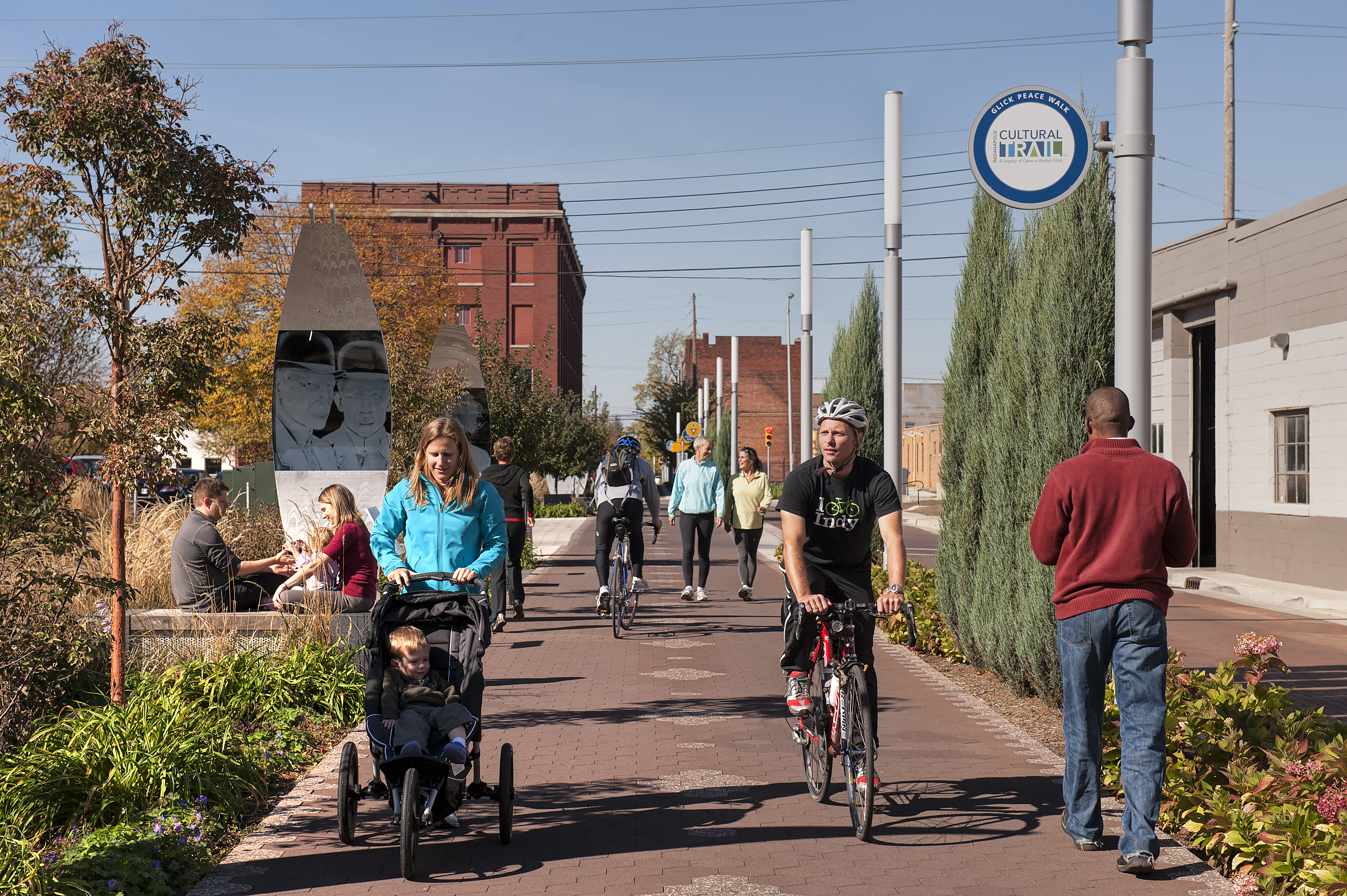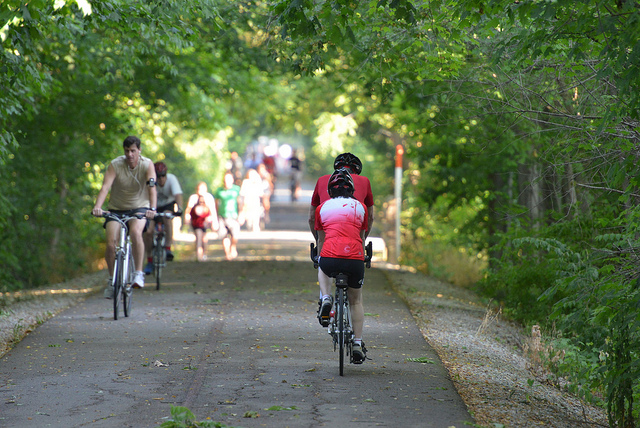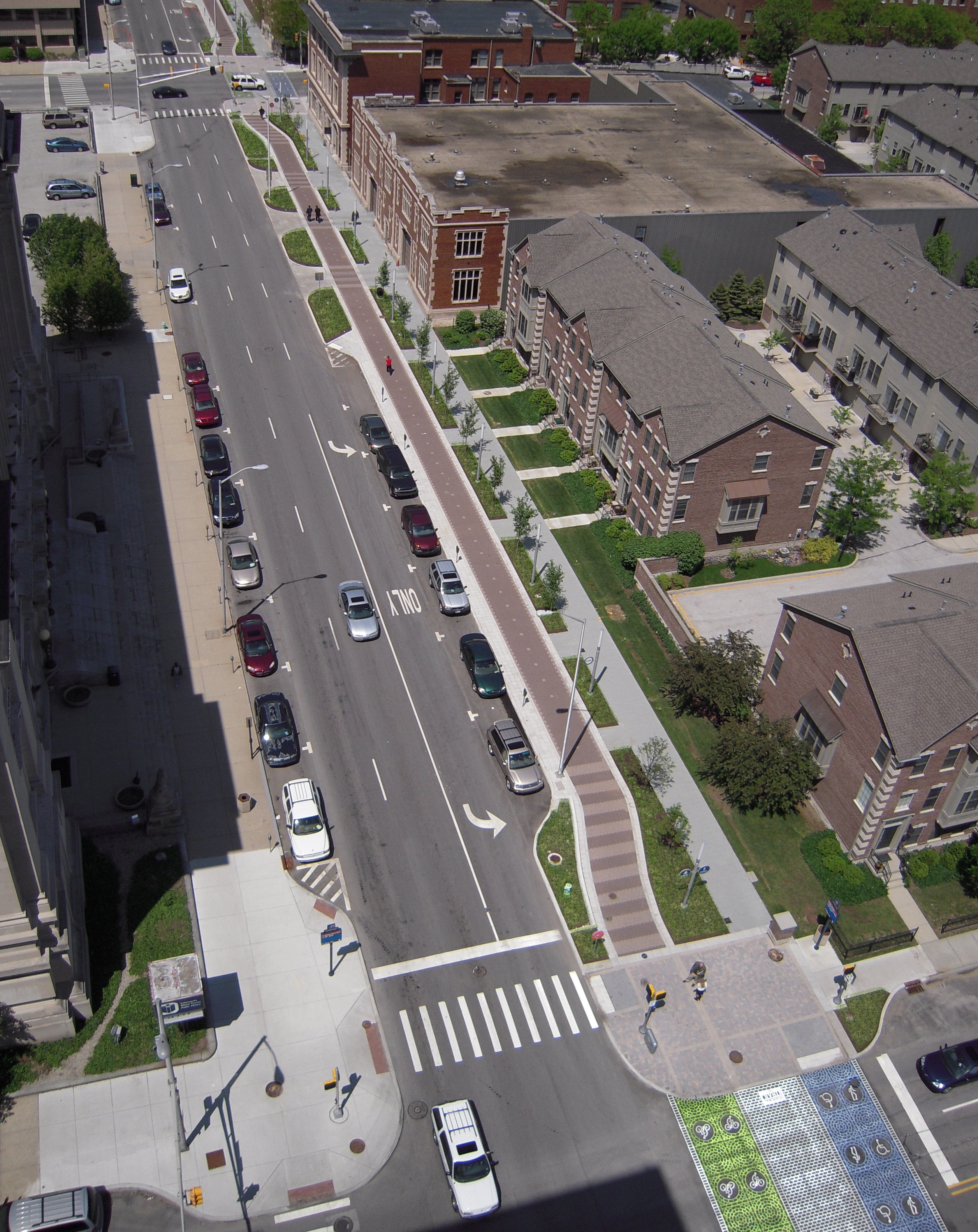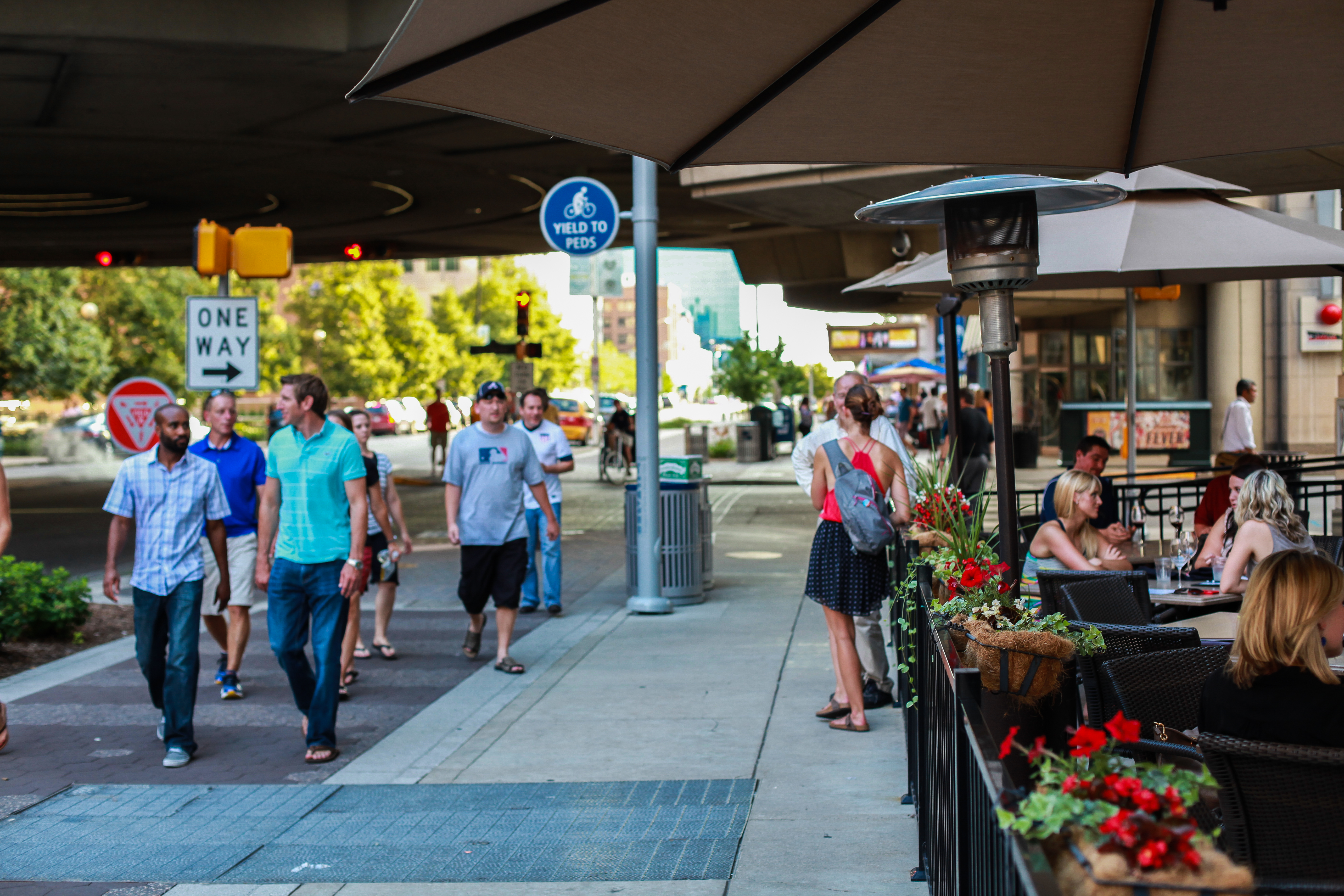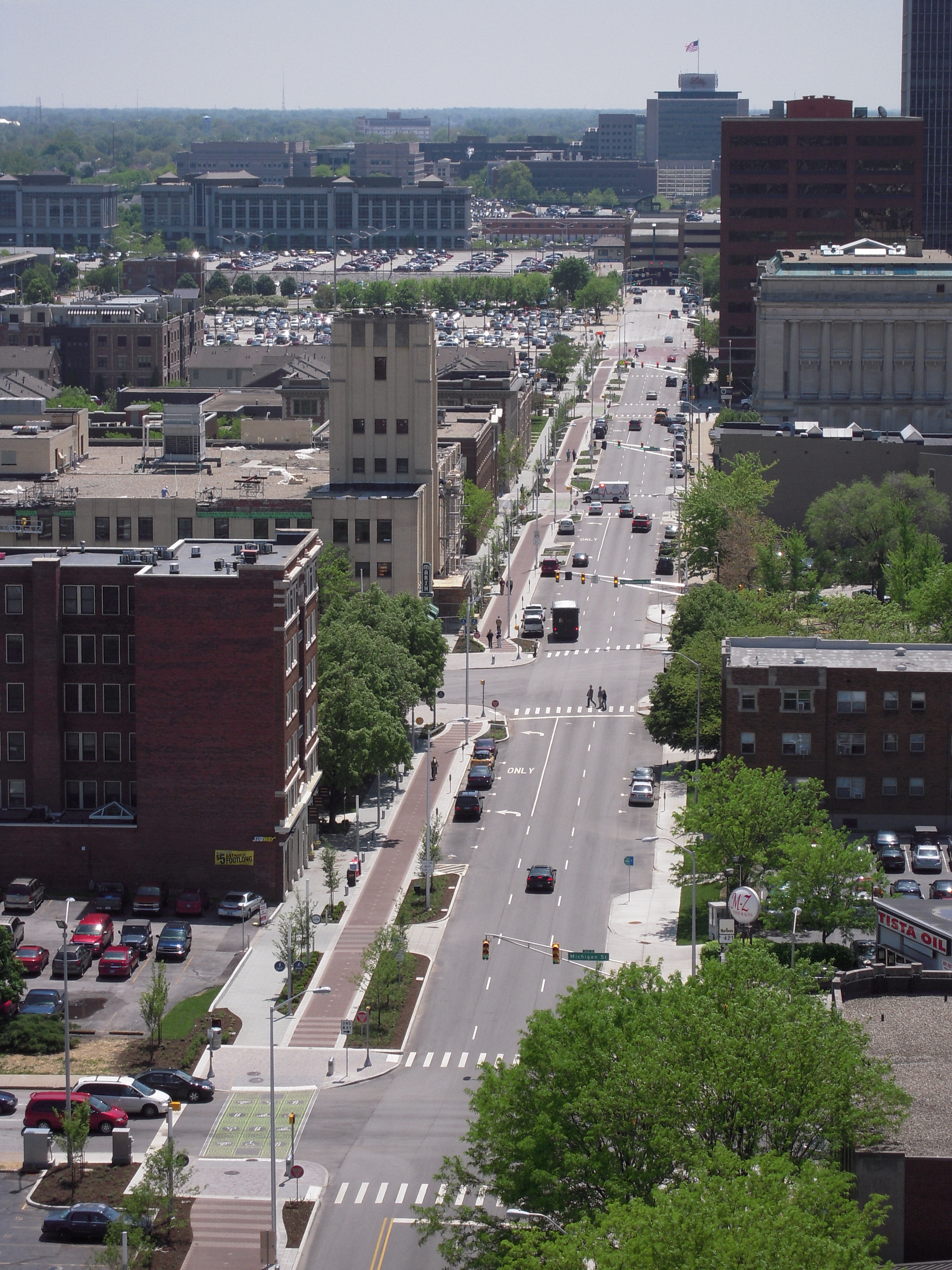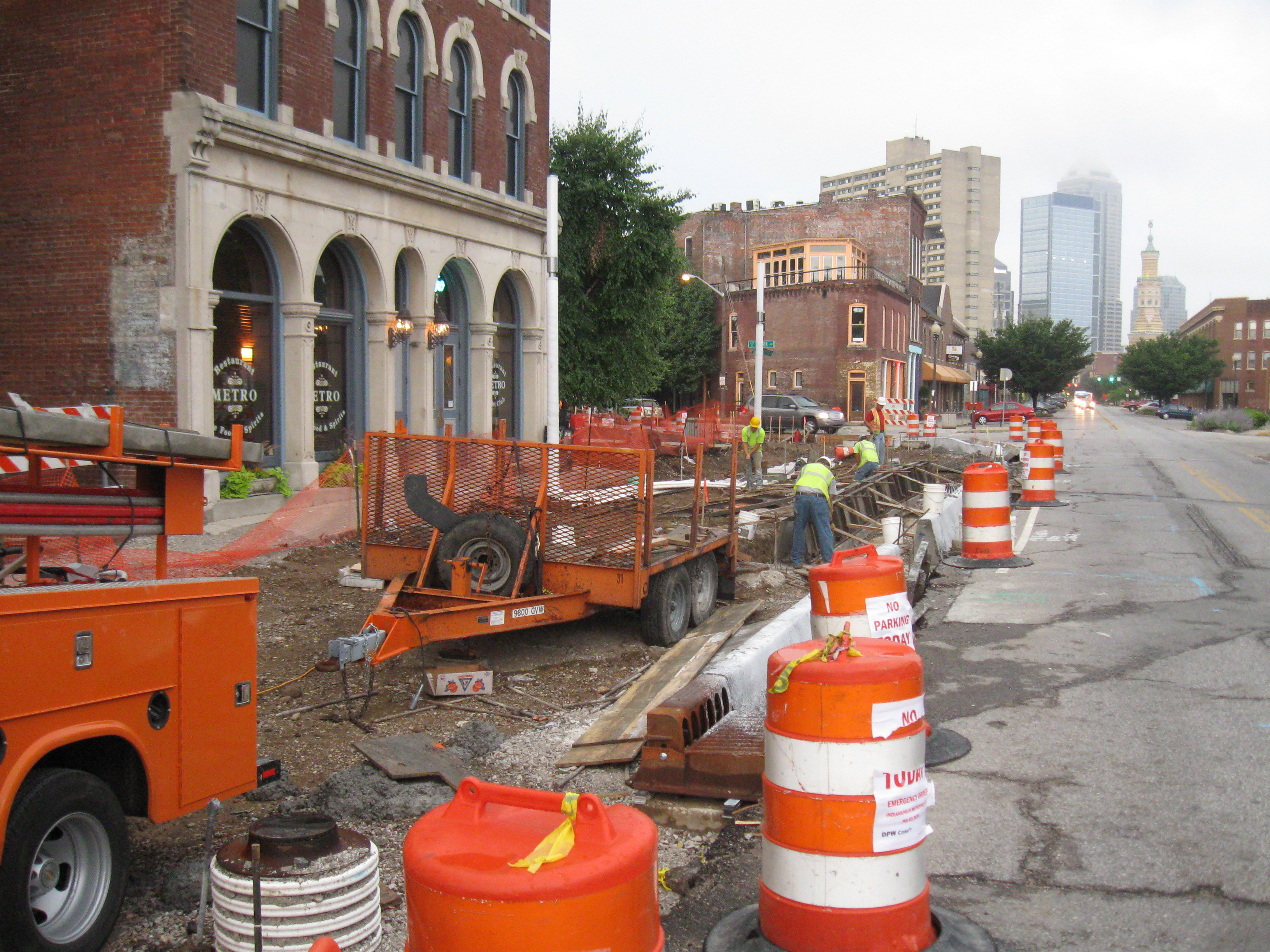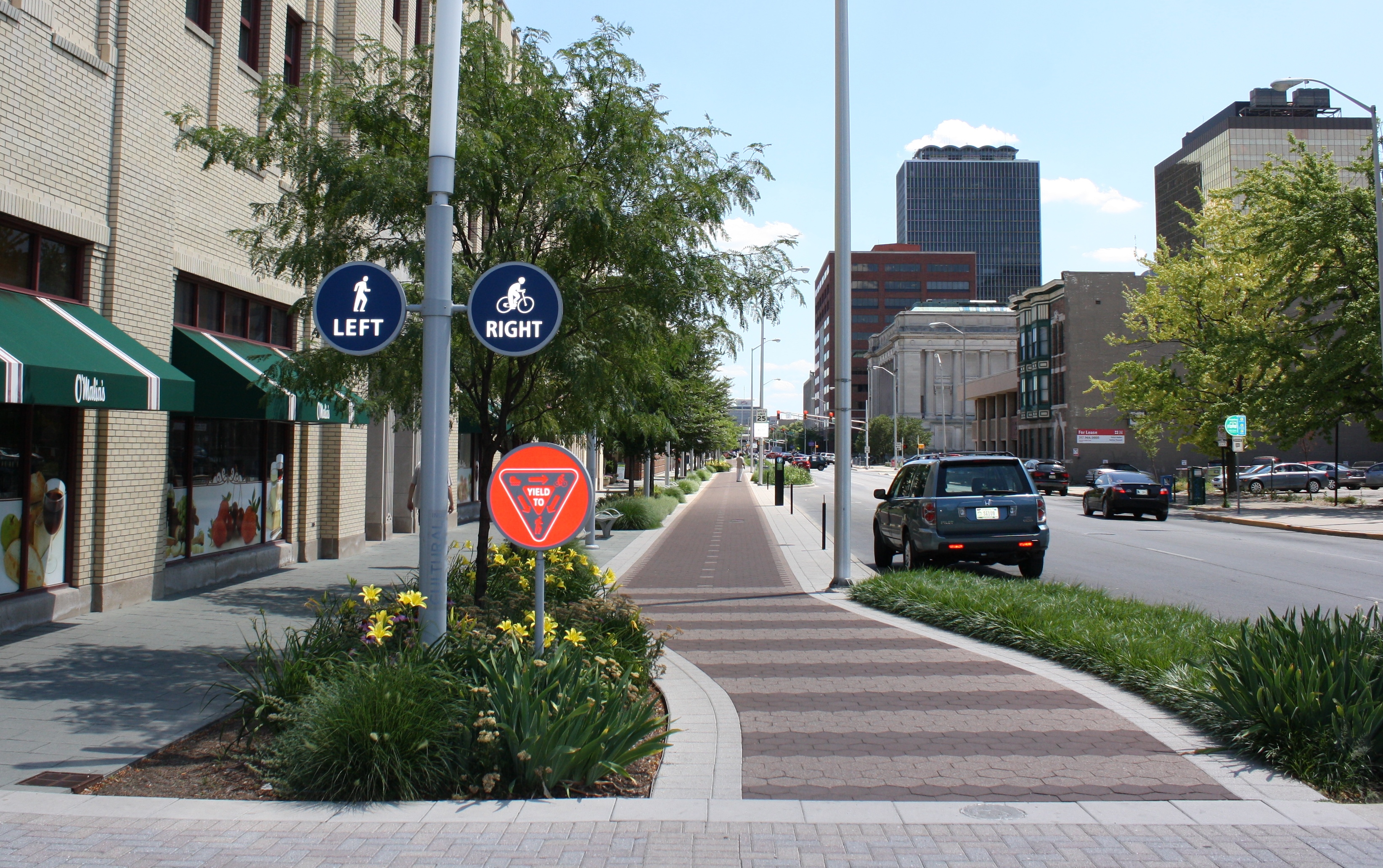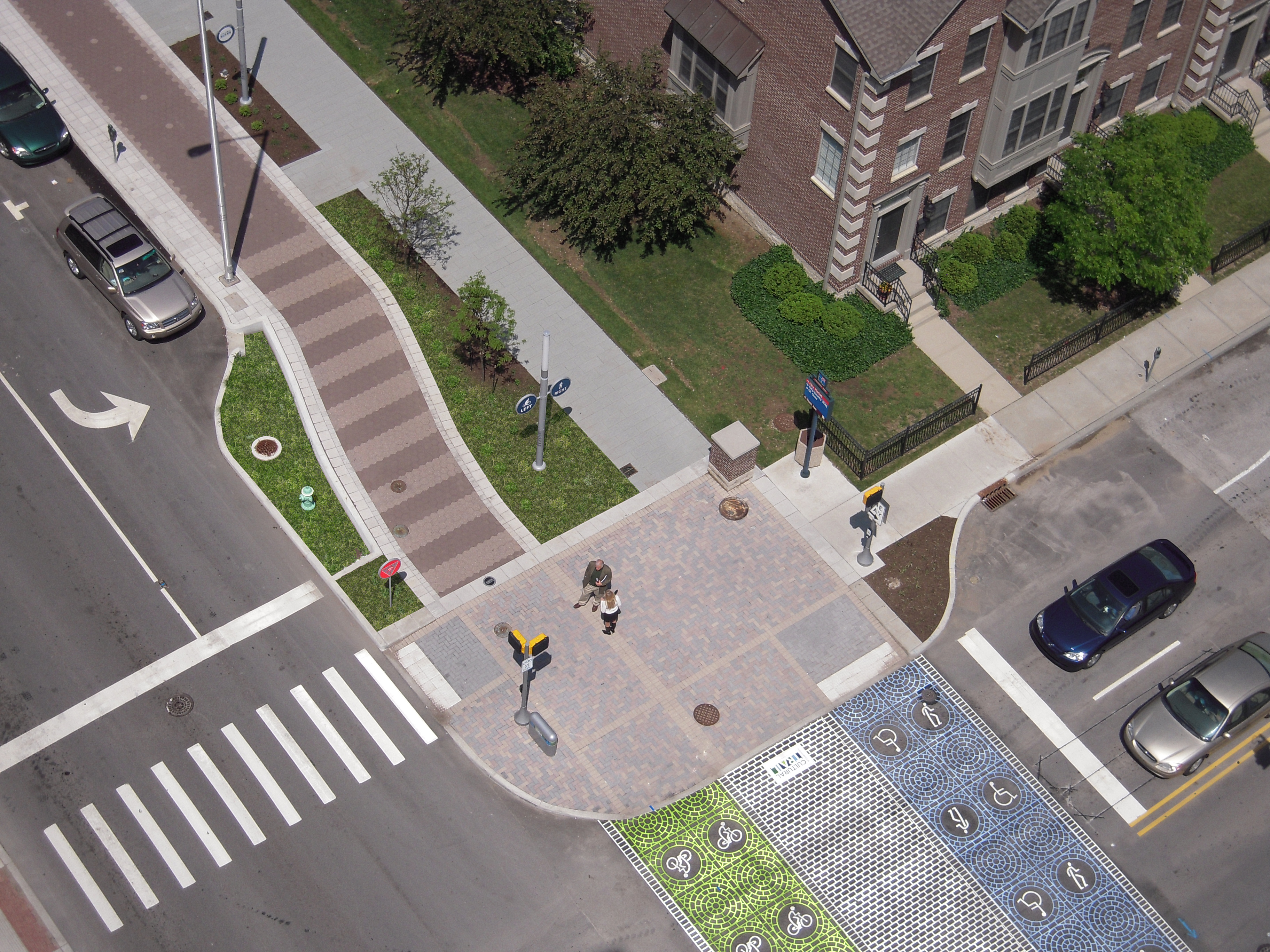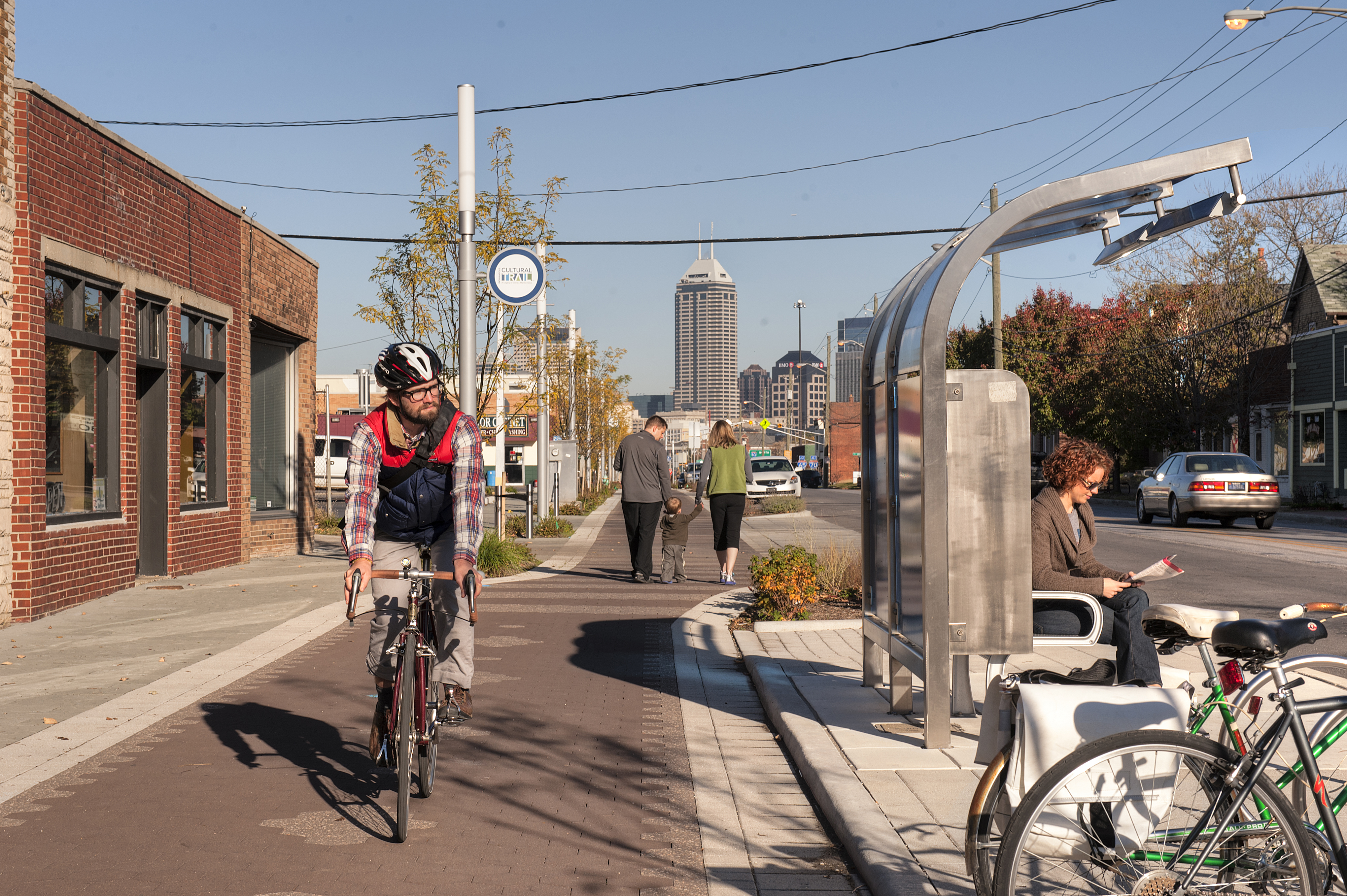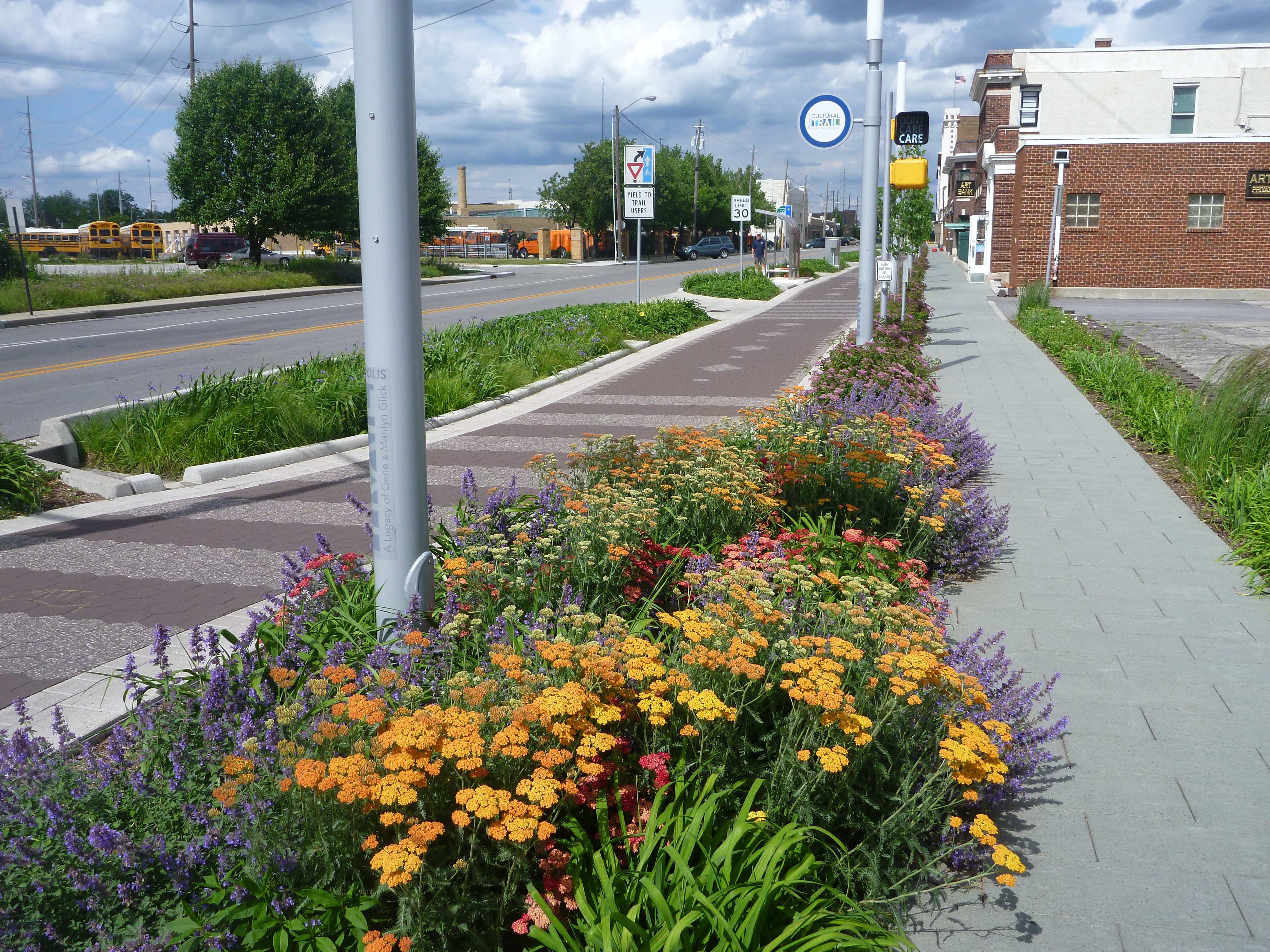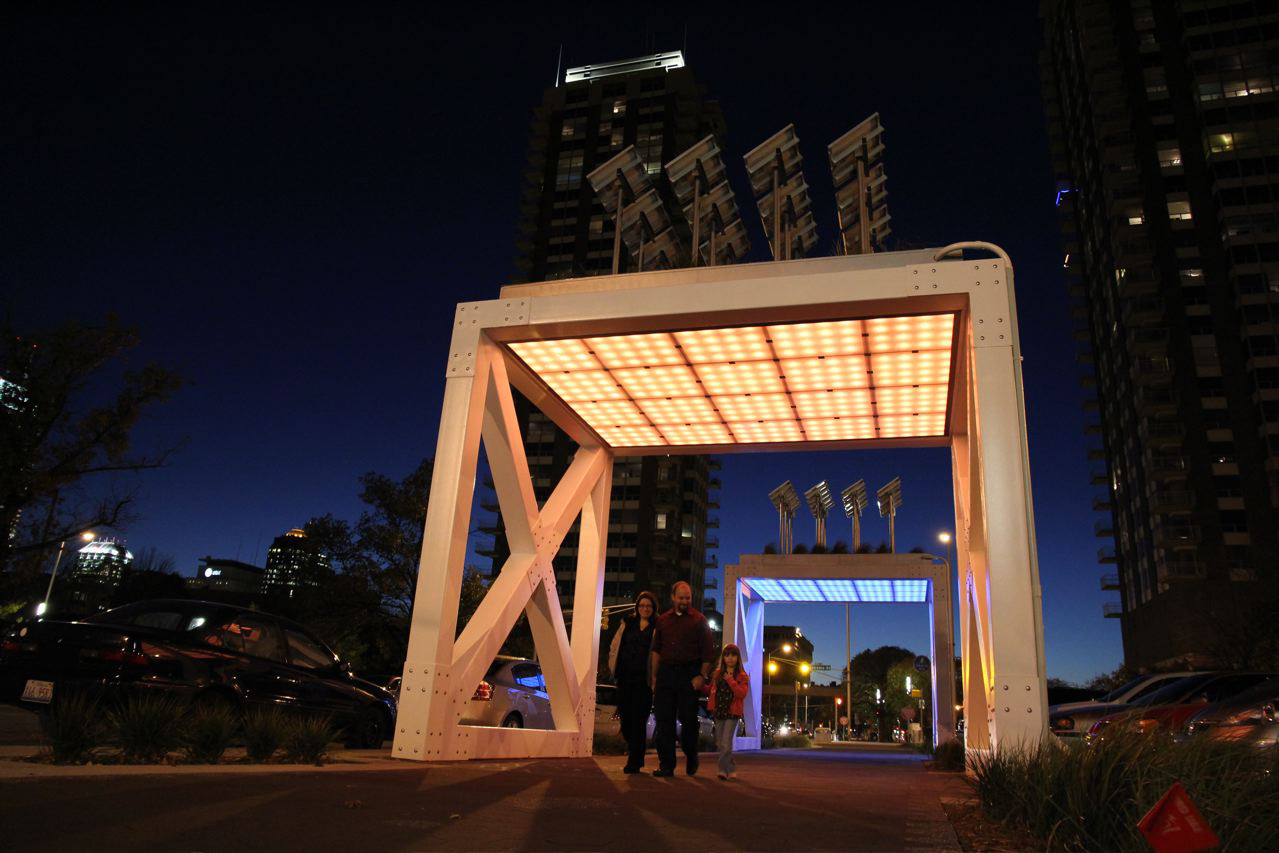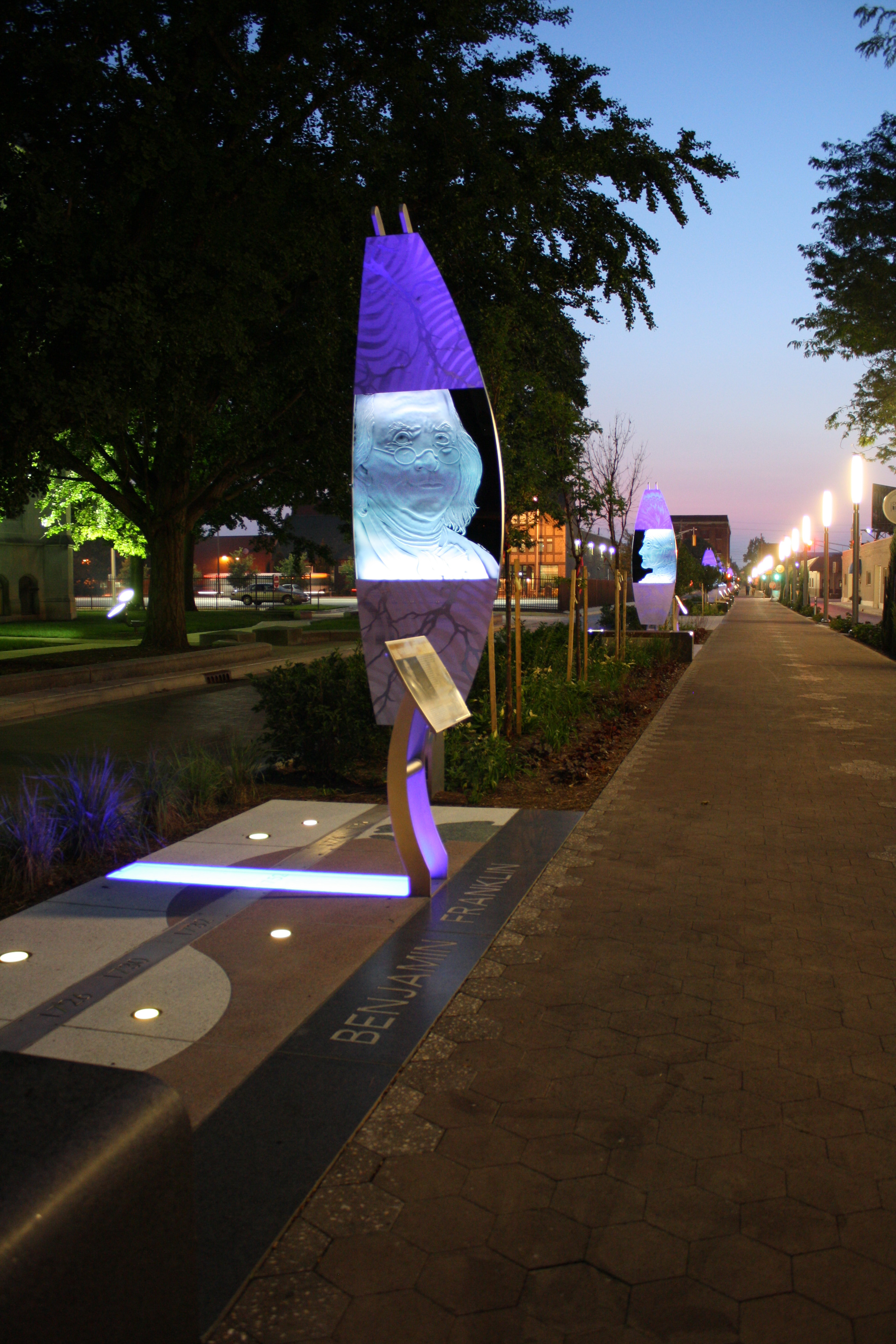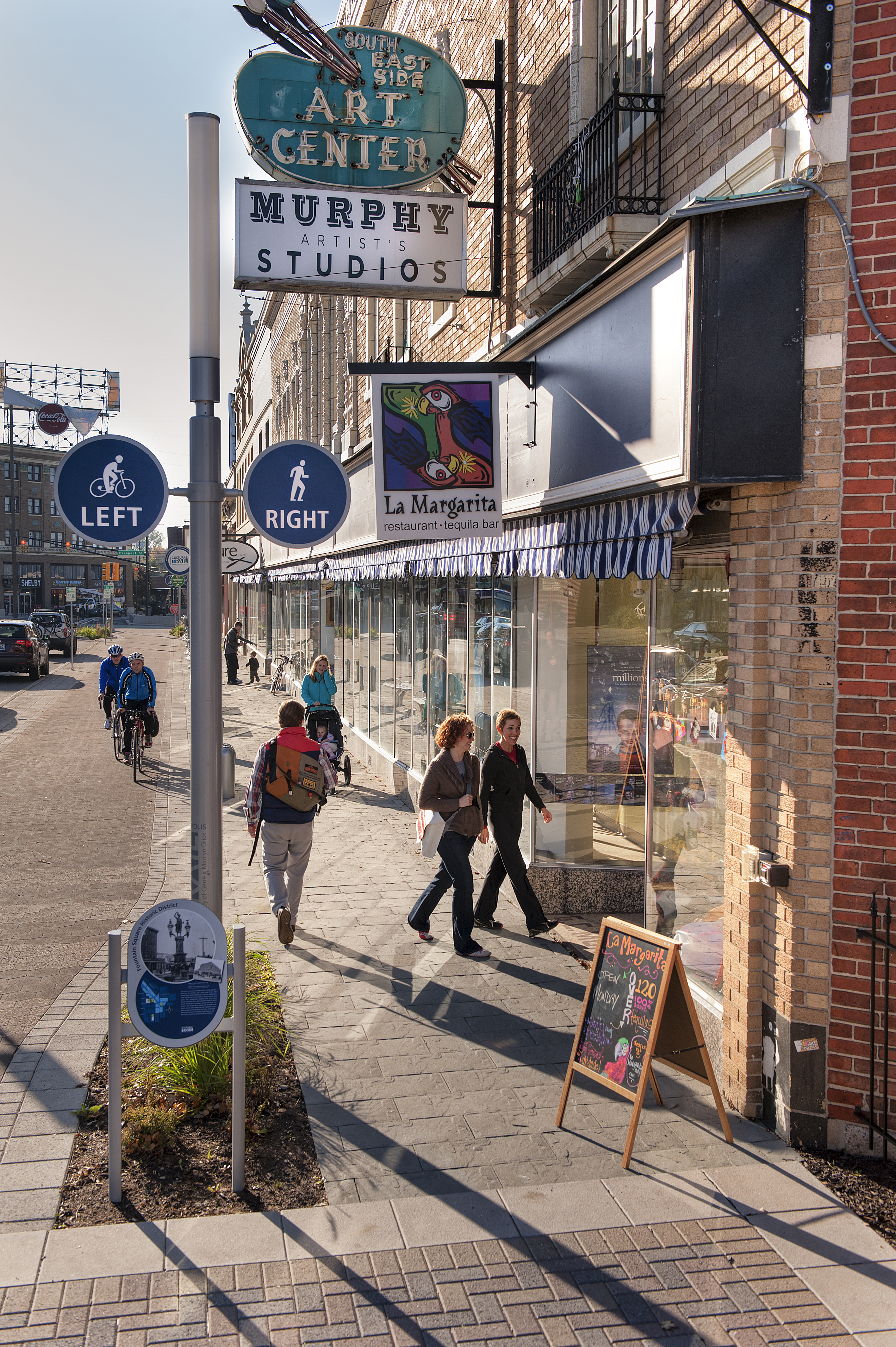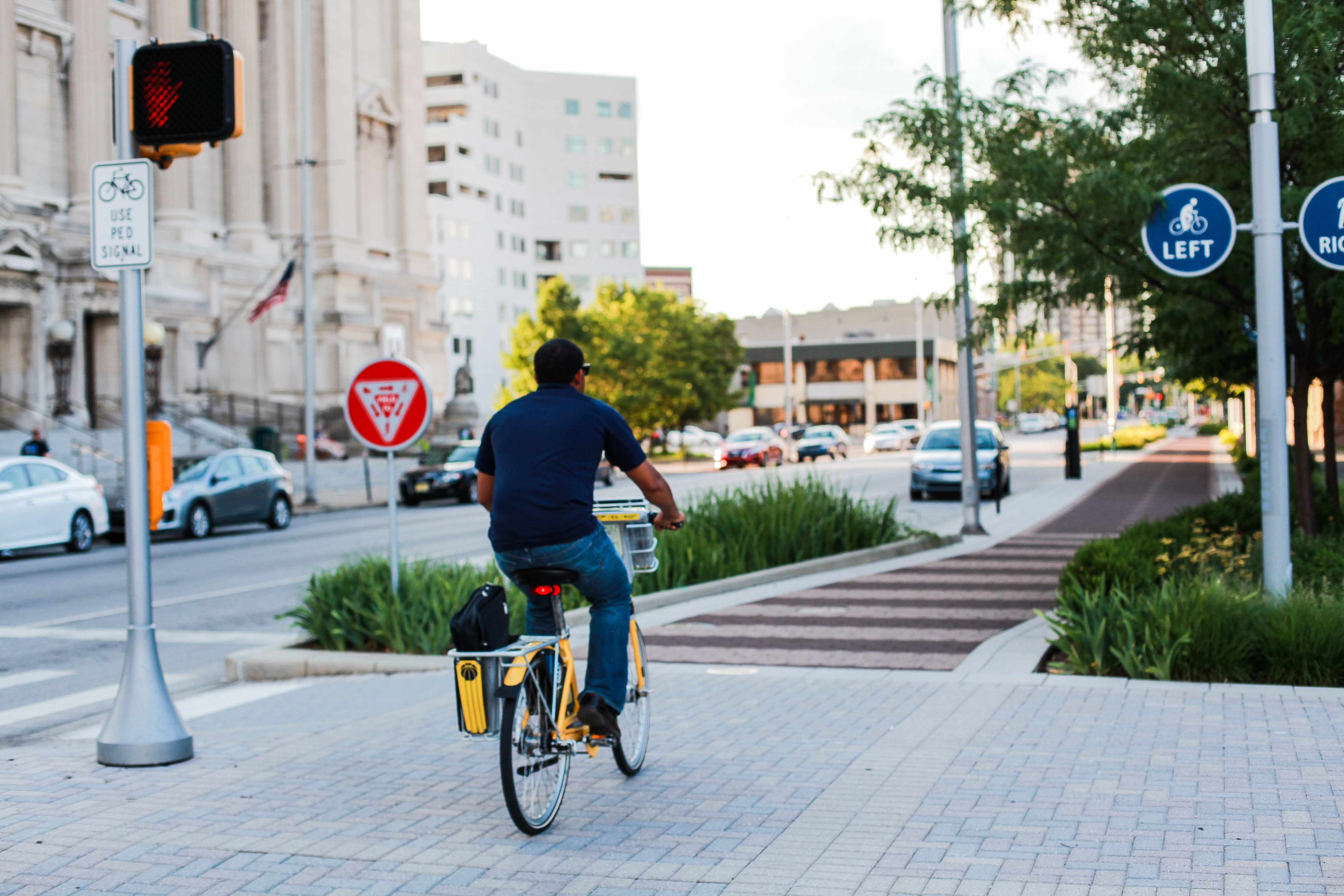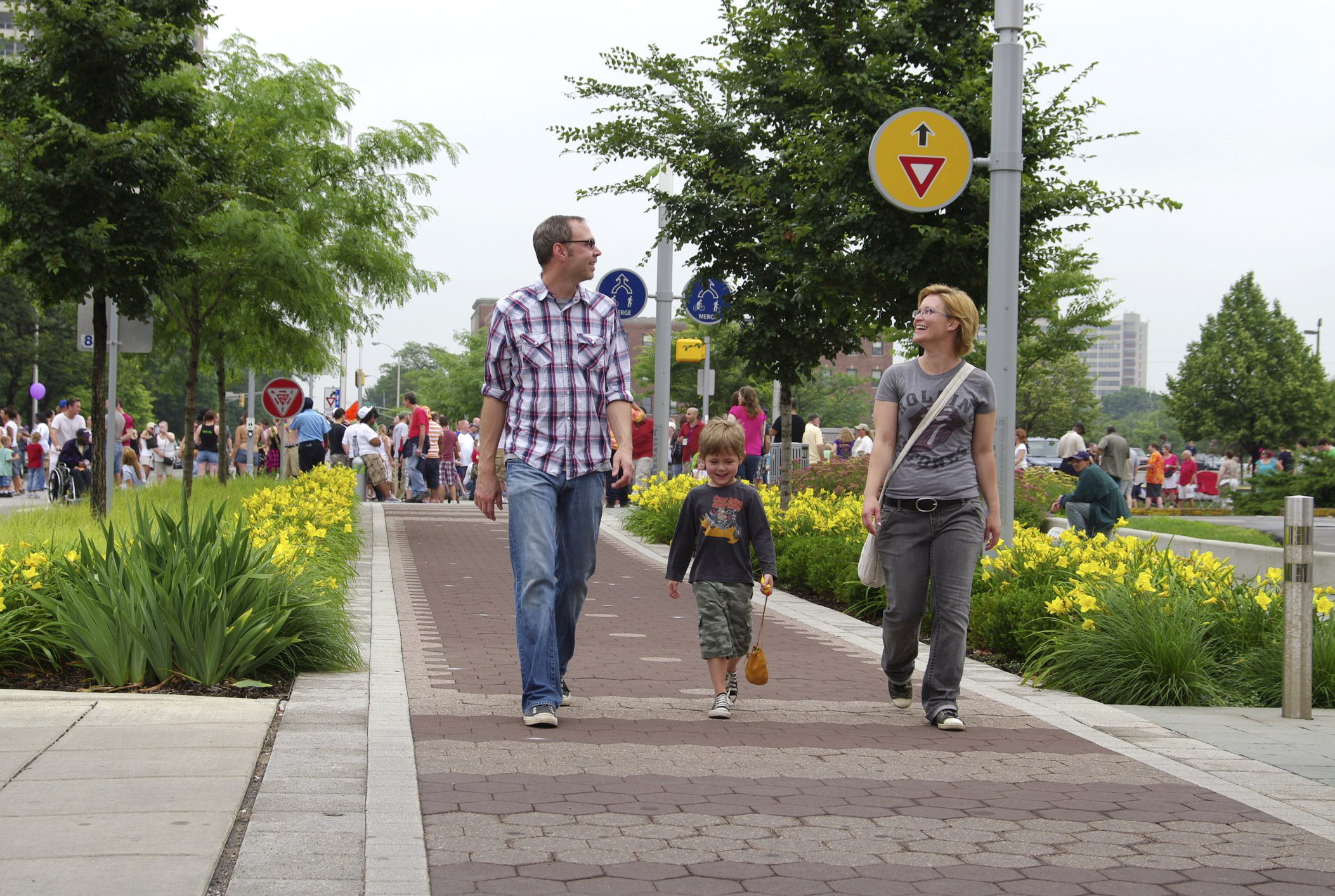Indianapolis Cultural Trail
Indianapolis, Indiana
Source: Pedestrian and Bicycle Information Center; Context Sensitive Solutions
Problem
The ICT has brought a significant increase in pedestrian and bicycle traffic to downtown Indianapolis as people of all ages and abilities have embraced the trail.
Indianapolis Convention and Visitors Association
Leaders in the city of Indianapolis, Indiana, wanted to make it easier for people to visit the city's cultural districts, which were disconnected from the heart of downtown and didn't get the attention they merited. In a city with a successful linear park and trail system, but no on-street bicycle facilities, one leader envisioned a bicycle and pedestrian trail through the heart of downtown Indianapolis. Twelve years later, the city, through a public-private partnership, completed the construction of an eight-mile, separated facility that forms a loop around downtown with spurs to connect five cultural districts and neighborhoods, as well as the city's greenway system.
Background
The Indianapolis Cultural Trail: A Legacy of Gene and Marilyn Glick was the big idea of Brian Payne, President and CEO of the Central Indiana Community Foundation (CICF); however, the trail's genesis was part of a broader effort to stimulate the city's economy and re-establish Indianapolis as a cultural center and destination. To accomplish this goal, Indianapolis Mayor Bart Peterson set out to define the city's unique cultural districts. As part of this initiative, Mayor Peterson vowed to deliver the city five million dollars over the first five years of his term to support the Cultural Districts Program, which highlights key locations in the city's downtown. “[The cultural districts] had all these great historic buildings, galleries, [and] theaters that were doing so-so. The idea was to make something of them,” said Payne.
Inspired by the Monon Trail, a converted railroad line that runs from the county line to downtown, Payne thought a similar trail in Indianapolis's urban center could provide the connectivity the cultural districts needed to thrive. Payne pitched the idea to the city's public works department and was told to “sell” the trail as a road diet.
Indianapolis was already defined by its wide streets and arterials that were friendly to motorists, and this was problematic in the downtown where cars could travel upwards of 50 mph. Removing a lane in downtown Indianapolis was regarded as a way to lessen negative motorist behavior and provide the city with a new transportation amenity.To gather momentum for the project, after taking his position at CICF in 2000, Payne spent four years informally pitching the project to various Indianapolis officials, philanthropists, and community leaders. He conducted more than 100 one-on-one meetings. For Payne, it was imperative to have the financing and credibility from community leaders before bringing the project to the public. Philanthropic donations provided enough money for a feasibility study and a small charrette process, which helped get the Mayor's office onboard.
Aerial view of ICT demonstrating Complete Streets design approach: pedestrian path, two-way bicycle facility, crosswalks, specialized signals, and traffic calming at intersections.
Rundell Ernstberger Associates, LLC
By 2006, Indianapolis was ready to hire two consultant teams, one for project management and one for the trail design. The project management team was brought on first to help represent the City of Indianapolis and Mr. Payne's vision of the project by overseeing the scope, schedule, and budget for the trail. The project management team also helped facilitate the selection of the design firm. Once the trail team was in place, they completed a more detailed feasibility study that identified the final route and provided accurate cost estimates. This study helped assuage concerns from the city's engineering department and provided valuable information for the team to share as they began the process to solicit input from residential, commercial, and institutional stakeholders.
Process/Solution
After the study was complete, the team's goal was to develop a pilot project as a proof of concept to show that a separated facility could work in Indianapolis's downtown. To guide the pilot project, the design consultants held a four-day workshop in June of 2006 to present the project to nearly 100 stakeholders including: city staff, elected officials, Indiana Department of Transportation, Federal Highway Administration, local philanthropists, public safety officials, transit officials, business leaders, neighborhood leaders, and CICF staff. The invited stakeholders heard presentations about best practices for successful trail development and interacted with a gallery of potential trail materials and design concepts. The workshop provided an important forum for discussion and helped build a broad consensus for the trail, which was important for the development of its first stage. The local Federal Highway Administration office also provided needed support for the project during its development process. The project team met several times and consulted with the office regarding the National Environmental Policy Act (NEPA) process, as well as, the proprietary items architects and donors wanted to include in the project.
Pilot Project
The first phase of the project, five blocks on Alabama Street, began construction in 2007. Alabama Street was selected because it was not in a historic district and the major land uses were institutional (e.g., city administrative buildings, an entertainment venue). These characteristics made implementation seem more straightforward. The Alabama Street pilot was constructed entirely from private money raised by Payne. The remainder of the Cultural Trail utilized private donations, as well as Federal transportation funds and a Transportation Investment Generating Economic Recovery (TIGER) grant. Since Alabama Street would serve as a model for the rest of the trail, it was critical to use the best materials and design practices. Moreover, the pilot was intended to build excitement and broader consensus for the rest of the trail. Having private capital available for this phase of the project made it much easier to apply the high standards the design team wanted.
From the very beginning of the project, the development team placed an emphasis on providing accessibility and worked diligently with the Mayor's Office of Disability Affairs. Alabama Street featured appropriate curb cuts and audible signals to make it accessible for everyone. The team placed early emphasis on sustainability. The pilot project included five recess planters that could capture, treat, and filter stormwater—a design that provides an important environmental service and would be applied to the rest of the trail.
The initial phase of the Cultural Trail was not problem-free. Indeed, the Alabama Street phase ran into a new development that had mistakenly built into the public right-of-way. To build consensus and more goodwill for the project, Payne worked with developers to move their fence and landscaping. Despite the setback, the initial phase was a rousing success, and proved that it was possible to remove a lane with few issues and add excitement for the project.
Public Input Process
The project's commitment to public engagement during its seven phases helped galvanize support for the development of the Cultural Trail. To spur development and explain the importance of Cultural Trail along the way, the project team held monthly brown bag lunches that kept people up-to-date on construction and next steps. Because each phase went through a different part of the city, each stage of development therefore required a new meeting. The project also had its own website that featured up-to-date content. The team also held several larger public meetings featuring 200 people that provided valuable feedback for the work ahead. Additionally, the Cultural Trail team met with community development corporations, business owner groups, as well as preservationists. Project team members even went door-to-door to reach residents and business owners. The success of the first phase demonstrated that this high level of engagement should be employed for the latter stages of the project.
Public Engagement Victories
The high level engagement helped mollify groups that were nervous about the project's development potentially harming their business. One example of such concerns was a group of businesses in the Fountain Square neighborhood that were already struggling financially. To ease their concerns and help their businesses during construction, the Cultural Trail development team ensured that the businesses had clear temporary access during construction and extra signage. Signs included maps that directed customers to parking.
Similarly, during the Massachusetts Avenue phase, the Cultural Trail project team listened to business owners and adopted its plans to protect their interests. The team decided that it would make Massachusetts Ave. a one-way street during construction to prevent complete road closures; however, businesses suggested that it would be most beneficial to make the road a one-way traveling in the opposite direction. After assessing their concerns, the team switched the one-way to protect business along the avenue. Their proactive approach paid off, as one of the property owners along Massachusetts Ave. saw the positive impact the trail brought his business and invested in another property along the trail by Fountain Square.
Residents also expressed concern over the design of the lighting since the entire length of the trail is lighted. To relieve their concerns, the team continued the conversation and brought neighbors to the construction site to show them what the lighting would look like. Most residents questioned the low-level lights placed about every 50 ft. on the trail so the team did more work on shielding the lights.
Lastly, the public engagement process was also critical to selecting the right art pieces that would adorn the length of the trail. For one segment of the trail, renowned artist Fred Wilson was selected to create a work that represented Indianapolis's African American community. Mr. Wilson's project called E Pluribus Unum was designed as a statue to commemorate the African American experience. Because Mr. Wilson's process relies on social dialogue that he weaves into his artwork, Mr. Wilson held a number of workshops that specifically targeted the African American community to acquire greater insight about their experience. After a series of discussions, Wilson's work was rejected. The artwork, as it was designed, was deemed unrepresentative of the interests of the African American community in Indianapolis. While Mr. Wilson's project was not the right fit for the city, the public outreach process was a success.
Design Elements
Pedestrian travel is separated from bicycle travel on this segment of ICT.
Rundell Ernstberger Associates, LLC
Since there were few comparable designs in the U.S. in the mid-2000s and little national design guidance, the team in Indianapolis turned to Project for Public Spaces (PPS) for support. PPS talked with engineers from cities like Copenhagen, Denmark; Bogota, Colombia; and Paris, France, which have had two-way separated bicycle facilities for years without major issues, and put together a best practices report to share with designers and officials in Indianapolis. Trail designer Kevin Osburn said that the team's conversations with PPS gave them the confidence to move forward with the idea.
The project was broken-down into seven phases constructed over a six-year span. The trail team felt it was important to have independent corridor concepts because each district has unique historic characteristics and environmental considerations. Plus, the team wanted to ensure that if there was an issue with one segment of the trail, the entire project wouldn't be delayed. The complete trail extends eight miles, with a loop around downtown and two spurs that connect to greenways. A little more than half of the trail is shared space for bicyclists and pedestrians, and the rest has pedestrian walkways that are separate from a two-way facility for bicyclists. For design width and buffers, the design team followed basic standards for shared-use paths—providing a minimum width of eight feet for separated facilities and 12 feet when the trail is shared by bicyclists and pedestrians. When the trail is divided, there is a four-foot buffer between the walkway and bicycle facility (enough space to plant trees) and another four feet from the bike facility to the curb line. At a few locations the trail does not have a curb because of drainage issues, but there is a flush curb with a larger buffer provided by a parking lane, aluminum bollards, or extra landscaping.
The streets in downtown Indianapolis were large (e.g., five or six lanes with 90 feet of right-of-way), so for most of the project the design team took away lane width (between four and 12 feet). In the oldest part of the city, the team was able to install separate facilities. Outside the original city center when there wasn't enough right-of-way, they went with a combined trail. In general, 12-foot travel lanes were converted to 10-foot lanes and 12-foot parking lanes were reduced to eight or nine feet. There was only one location where a parking lane was removed, but there was no pushback from the public because it was in front of an entertainment venue that had its own parking lot.
The design team bumped out the curbs to reduce crossing distances and used special pavement markings in the crosswalk.
Rundell Ernstberger Associates, LLC
Improving safety for all users at intersections was one of the project team's goals. Eliminating right turns on red was part of the process; as well as constructing a chicane in the bicycle facilities leading up to intersections so that bicyclists remain alert and do not cruise through the intersection. At every possible location, the team bumped out corners to shorten the crossing distance and create a big queue area for pedestrians and bicyclists to mix. These corner plazas are about 25-feet wide so that users can turn without running over each other. To make the trail universally accessible, almost every corner was rebuilt with new ramps that have an Americans with Disabilities Act (ADA) compliant arrival and departure point. If the trail is separated as it approaches the intersection, there are two ramps—one for pedestrians that includes truncated domes and one for bicycles that is smooth. The construction of the trail also offered an opportunity for the city to install countdown timers and audible signals at traffic lights. Initially some residences complained about the beep of the signals, so their volume was reduced, but they remained audible over traffic.
The ICT supports multimodal connectivity with custom designed transit stops along the trail corridor.
Indianapolis Convention and Visitors Association
Coordinating with transit was also a necessary component of the project since about one-quarter of the trail is on transit routes. The team talked with IndyGo, the Indianapolis Public Transportation Corporation, about constructing bus platforms and whether they could include bike parking. The team typically raised the bus stop curb higher than the trail and installed a 12-foot wide platform and ADA-compliant ramps leading to the platform. At bus stops, the trail was bent back toward the property line to go around the platforms. Transit also presented an opportunity for incorporating public art into the trail—the project included seven custom-designed, eco-friendly bus shelters that showcase original poetry by local published writers. The seven custom bus shelters were designed by Indianapolis-based architect Donna Sink so that the sun illuminates the colored graphic and casts the shadow of the words on the sidewalk.
Sustainable Design
Generous use of planters filled with drought tolerant plantings provides buffers between travel modes, filter and capture stormwater runoff, and add vibrant color and textures on a year-round basis.
Rundell Ernstberger Associates, LLC
The trail benefits the City of Indianapolis beyond providing a new transportation option—with an estimated 25,000 square feet of stormwater landscaping, the trail doubles as a streetscape beautification project. Stormwater landscaping helps divert approximately four million gallons of rainwater per year. Public Works Director Lori Miser said the team was conscientious about making sure they were as sustainable as possible in the design and construction of the trail. Since the city had never used stormwater planters before, the project team was allowed to install five planters as a pilot along Alabama Street. The recess planters allow water to be captured and slowly drain into the ground. The economic argument for the planters is that you are no longer paying to treat the water once you take stormwater out of the municipal treatment system. Kevin Osburn said the planters turned out to be one of the most successful components of the trail and are now a tool in the city's toolbox.
Public Art
The public art installation, "Prairie Modules," recalls historic steel truss bridges and featurs color changing LED lights powered by rootop solar panels set amid green roof plantings.
Photo by M:12
Since the trail was designed to pass by and pass through many of the cultural destinations in Indianapolis, the trail also was planned as a space for public art. The public had a lot of say in the art, starting with the design charrette that took place at the beginning of the design process. Deputy Program Manager Mark Zwoyer said it was a community effort to look at “what's needed and what makes sense” to include along the trail. A public art consultant was hired, and she assembled a Curatorial Advisory Committee that helped select artists after a call for projects. When different segments of the trail passed through historic districts, the team had to work with the state historic preservation officer. The trail includes interpretive signage about historic uses and art installations that highlight the uses. For example a historic alley on Massachusetts Avenue includes a vault with an ornate lattice cover that references a former hosiery factory and a vent that releases a floral aroma that recalls the luxury of the silk hosiery.
The Glick Peace Walk, named for major donors Gene and Marilyn Glick, transformed an underutilized vehicular corridor into a destination civic space with dynamic public art that celebrates the lives and peaceful pursuits of fourteen individuals who made significant contributions to humankind.
Rundell Ernstberger Associates, LLC
Fundraising
Indianapolis could not afford to fund the project, and asking for city and State tax-payer subsidy was not an option. Before the project even began (2001-2005), Payne worked diligently to reach folks who had financial sway. By having more than 100 one-on-one meetings, the project was able to get more traction and it allowed Mr. Payne to gain access to donors. The City of Indianapolis worked with Mr. Payne to sketch out the idea for a trail project that would cost about $25 million. With the sketch in hand, Mr. Payne was able to raise $3 million from a few individual funders and foundations, which made the project a more realistic venture and provided momentum to raise additional funds.
Next, the Mayor committed to raising $15 million in Federal transportation funding, and in 2006, Eugene and Marilyn Glick donated an additional $15 million for the naming rights. After raising additional private funds and completing three miles of trail, Indianapolis was awarded a $20.5 million Transportation Investment Generating Economic Recovery (TIGER) grant in 2010. In all, $27.5 million was raised from private donations and $35.5 million in Federal funds were applied to project, for a total cost of $63 million. Nearly $20 million was needed for relocating utilities and to replace aging city infrastructure like sewers and roadways.
Trail Oversight
When trail construction started, all partners involved knew that they wanted a separate non-profit to operate and maintain the trail. Mr. Payne established Indy Cultural Trail, Inc. (ICT Inc.) toward the end of construction, modeling ICT Inc. after the non-profit that oversees Central Park in New York City. ICT Inc. is the “voice of the trail” that exists as a partner to the city. The ICT Inc. staff works to determine the needs of trailside residents and businesses and constantly coordinates with the city. As part of fundraising for the trail, CICF built a maintenance endowment of $6 million, which is now administered by ICT Inc. to cover issues such as landscaping, electrical maintenance, and snow/ice removal. Lauren Day of ICT Inc. said that because the trail is cleared of snow and ice in the winter, people in wheelchairs and those who rely on walking/biking year round know that they'll have a clear, safe path. She said that in the winter of 2013/14, they observed people in wheelchairs using the cleared trail to access bus stops. Other maintenance issues are covered by a Memorandum of Understanding between ICT Inc. and The City of Indianapolis. It states that the Department of Public Works is responsible for keeping the trail pavers clean and replacing hardscape elements that are in the public right-of-way (signals, lights, pavers) and the special Duratherm markings used across the intersections. The city also pays for the electricity and water, which includes drip irrigation for the trail.
Local businesses on Virginia Avenue in the Fountain Square neighborhood. The ICT has generated millions of dollars of private investments in new business and housing.
Indianapolis Convention and Visitors Association
Results
The last phase of the trail was completed in December of 2012, with small construction issues resolved in 2013. The loop now connects all the cultural districts and is within two blocks of all important cultural destinations. Ms. Miser has observed that “commuters use it because it connects to greenways, people are using it for leisure, then there is the lunch-time crowd who uses it for exercise.” She said that because of all the landscaping, it serves the city as a linear park.
Well before the trail was completed, new construction and redevelopment started popping up along the route. It is important to keep in mind that the ribbon cutting for the Alabama Street segment was in June 2008, right as the economy was collapsing. Despite the economic climate, over $300 million of new development has been constructed along the route since 2008 (this figure only includes developers who said they chose their site because of proximity to the trail). An analysis of tax assessment data from 2007-2010 showed a small increase in assessed value along the Cultural Trail (0.1 percent), while properties in Center Township (which includes downtown Indianapolis and part of Beech Grove, Indiana) decreased by 1.2 percent. Moving forward, Mr. Payne said it will be important to continue examining parcel tax assessments (and comparing them to control parcels) and food/beverage tax revenue because the visitor's bureau has been using the trail as its number one marketing strategy.
The Cultural Trail is seen as a catalyst for revitalizing downtown and some of its historic neighborhoods—vacant lots have become restaurants with outdoor seating and businesses are touting their proximity to the trail. Local developers have opened several mixed use, multi-family developments and the trail has provided a new type of access and an amenity to previously struggling areas of the city, like Fletcher Place and Fountain Square, which was cut off by the downtown interstate and lacked safe bicycle and pedestrian facilities. The Cultural Trail connection also helps these neighborhoods access greenways and bike lanes. Since the trail is designed for everybody, people can comfortably travel 10 mph or less to get from place to place.
Pacers Bike Share: Enhancing Equitable Access to Downtown
Part of making sure that everyone had the opportunity to travel on the Cultural Trail (and the greenways and new on-street bike lanes) was bike share. From the trail's inception, Payne always thought that some type of system for lending bikes would enhance the trail experience, and by 2003 he started to hear about automated systems. By the time trail construction was wrapping up, many of the kinks of these systems had been worked out. The city applied for Federal Congestion Mitigation and Air Quality (CMAQ) funding that paid for $1 million in capital, then received a philanthropic gift for the naming rights from the foundation that owns the Indiana Pacers. Having the name of the city's professional men's basketball team on the bikes provided an automatic opportunity to market to a different group. The system launched in April 2014 and has continued to exceed ridership expectations. Most of the stations are on the Cultural Trail, or within a couple of blocks, so people are immediately oriented and don't have to worry about finding the next station. Plus, there are plenty of directional signs. Mr. Payne had a feeling that bike share would be a success because the Cultural Trail is such a comfortable facility for all users and now they are looking at now to expand into the neighborhoods that are asking for bike share stations and businesses are asking about how to sponsor stations near their office.
To ensure access to the bikes, Pacers Bike Share is working with the Indiana Housing Authority to provide discounted annual membership ($10 rather than $80). They are doing on-site registration to help answer peoples' questions and to make sure people know bicycling may be faster that buses for some short trips. Ms. Day said her organization is making efforts to diversify ridership so people are using it for all kinds of trips—to the grocery store, the library, work, etc. “We need to have equity of access to the system, especially if we want to say it is part of the public transportation system,” said Ms. Day.
Building off Success—A Connected Network
The Cultural Trail project started before there were any on-road bike facilities in Indianapolis. Because of the work that Mr. Payne did early on, the money and the research were ready for when the city applied for Federal grants. Now there are 85 miles of bike lanes and other facilities in the city. The project was seen through by a Republican mayor and a Democratic mayor, and it was the Mayor's Office that found the funding to create a Bicycle and Pedestrian Coordinator position in the city.
To jumpstart the city's network, staff went after the low-hanging fruit—wide roads that could easily incorporate striped bike lanes. There are now about five sets of bike lanes that intersect the Cultural Trail including an east-west commuter route and a North-South route where small changes were made to the width of the bump outs to allow for bike lane striping.
In addition to bike lanes, the city also is working to provide comfortable connections between the Cultural Trail and the city's greenways. For example, at the southeast corner of the trail along Shelby Street, the city has installed a separated bike lane that connects to the Pleasant Run Greenway and then striped a bike lane on Shelby Street after the intersection with the greenway. While it is unlikely that the city will be able to continue with the sophisticated (and expensive) level of design that was used for the Cultural Trail, Indianapolis continues to prioritize the development of infrastructure that promotes a low-stress bike riding experience. As part of this effort the city intends to install separated two-way bicycle lanes on New York and Michigan Street in 2015. Indianapolis is also spearheading the development of bike boulevards. This effort relates to the city's current work with the national advocacy group People for Bikes to further enhance its protected bike lane network. According to the city's 2012 Bicycle Master Plan, Indianapolis is on track to have a total of 100 miles of on-street bicycle facilities by the end of 2015.
Acknowledgments
Information provided by Brian Payne (Central Indiana Community Foundation), Lori Miser (City of Indianapolis), Kevin Osburn (Rundell Ernstberger Associates, LLC), Mark Zwoyer (CHA Companies, formerly RW Armstrong) Melody Park (City of Indianapolis, formerly with RW Armstrong), Jamison Hutchins (City of Indianapolis), and Lauren Day (Indy Cultural Trail, Inc.)
This case study was drafted in collaboration with Context Sensitive Solutions.



